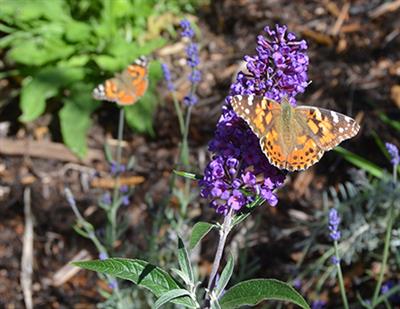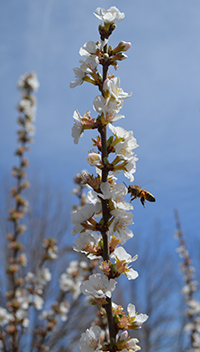 It seems that everyone knows the plight of the honeybee, and the effect it has on our food system. However, did you realize that Colorado has over 950 native species of bees who also pollinate? Not to mention the native and migrating butterflies, birds, moths, and don’t forget bats. Yes, bats are pollinators too and provide mosquito control. These 10 steps will help most if not all of your winged visitors.
It seems that everyone knows the plight of the honeybee, and the effect it has on our food system. However, did you realize that Colorado has over 950 native species of bees who also pollinate? Not to mention the native and migrating butterflies, birds, moths, and don’t forget bats. Yes, bats are pollinators too and provide mosquito control. These 10 steps will help most if not all of your winged visitors.
- Don’t use pesticides! Resist the urge to spray your dandelions, especially while in bloom, when the insects are visiting them for nectar.Remember, birds are insectivores and if you kill all the insects, what will the birds eat? Let nature balance the populations.
- Plant a diverse landscape. Variety is the spice of life. If you plant a monoculture of grass and one variety of tree, you risk losing it all to disease.
- Plant early, mid-season and late season bloomers and night bloomers. By sequential planting, you are sure to provide nectar throughout the season.Night blooming plants will appeal to the moths and bats.These flowers are often white or yellow.
- Plant natives. Native plants provide a better quality nectar and encourage native pollinators.
- Plant in layers.Replicate nature with tall trees, ornamental trees, shrubs and perrennials.By layering the garden you provide plant diversity to encourage more wildlife diversity.
- Add water. All living things need water.By providing a pond, creek or birdbath, you provide a clean source of water for all your winged friends.A shallow saucer with gravel, rocks or even wood floating in it provide a safe place the bees.A glazed birdbath is too slick and bees can drown.Give them a rough surface to hold onto while getting a drink.
- Bee a lazy gardener. Resist the need to clean up everything in the fall.Dead
 branches and stalks on flowers provide a winter home for native pollinators.Save it for spring.Likewise don’t rake up all the branches and twigs; the birds use them to make nests.
branches and stalks on flowers provide a winter home for native pollinators.Save it for spring.Likewise don’t rake up all the branches and twigs; the birds use them to make nests.
- Provide habitat and housing. A simple 4x4 cedar post with holes drilled into it allow bees to crawl in.
- Leave bare dirt.Organic mulch is good for many reasons, but make sure to leave some bare soil for ground nesting native bees.The can’t burrow through the mulch. I leave 3-6 inches around my plants of bare soil.
- Add bat boxes.Bats get a bad reputation, but they are voracious insectivores eating their body weight in insects each night.They don’t just eat mosquitos, they also eat many agricultural pests too.Nectar-feeding bats are critical pollinators helping plants produce seed. Bats also help disperse seed, restoring new growth under forests. Additionally, bat guano makes a nutrient rich soil amendment. You can collect it from under your bat box.